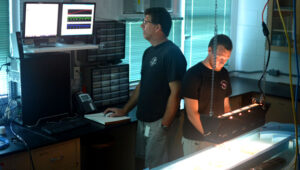CREOL Debuts New Lab to Study Reef Ecosystem Efficiency

The traditional method for assessing reef health involves fieldwork; that is, going out to the reef in question and taking measurements (e.g., percentages of each coral species, etc.) of the coral, algae, and other bottom types that are present. However, these measurements only present one aspect of health: ecosystem structure. To develop a more complete picture of reef health, scientists also need to understand and be able to assess ecosystem function. In the case of coral reefs, this means quantifying the two main things that reefs do as an ecosystem: primary production (or photosynthesis) and calcification.
Using primary productivity as a measure of ecosystem function can prove tricky, however, because photosynthesis relies on sunlight, and the amount of sunlight can change day-to-day, even while the reef itself remains the same. An alternative often used in terrestrial science is the concept of light-use efficiency (LUE), which describes how well a plant or plant community converts light energy (sunlight) into chemical energy.
LUE is calculated by taking the rate of photosynthesis and dividing it by the amount of light that is absorbed into the system. Instead of simply measuring the light coming into the system, efficiency takes into account the fact that two different reefs—with two different compositions of coral, algae, and sand—will have different rates of photosynthesis because each of these components absorb light differently. The light that is absorbed, not what is available, is the light that is available for photosynthesis.
Since efficiency doesn’t change day-to-day according to the weather, it also serves as a measurement that is sensitive to ecosystem-wide perturbations, such as coral stress (e.g., bleaching/disease) or widespread damage (e.g., from hurricanes). Higher LUE means that corals/algae are in good growing condition and can photosynthesize at a faster rate. Conversely, lower LUE means that corals/algae may be experiencing some kind of physiological stress and, thus, photosynthesize at a slower rate.
The Coral Reef Ecology and Optics Lab (CREOL) at BIOS recently constructed an experimental flume mesocosm to measure efficiency for reef communities. Using live coral specimens, a recirculating flume, and a variety of scientific instruments, Dr. Eric Hochberg (PI) and his staff can make continuous measurements that will provide insight into this important, but under-studied, concept. The flume allows them to measure the photosynthesis rate of the corals (using a CTD and an oxygen probe), as well as how much light is being absorbed (using two spectrometers: one that measures the light coming down to the corals and one that measures the absorptance of the corals). Taken together, these measurements can be used to calculate efficiency of the coral community.
When asked about his work, Dr. Hochberg said, “I’m really excited about the prospects of this research. With this flume, we’re going to be able to explore some basic questions about how reefs work in terms of light-use efficiency. We can see whether different coral species or different types of algae have different LUEs. We can look at how LUE changes under different environmental conditions by changing water temperature or nutrient levels. This concept of LUE is novel to reef science, so we’re going to be opening a new area of research that I think has the potential to change our understanding of reef function.”
You can learn more about Dr. Hochberg’s work and CREOL by visiting /research/projects/coral-reef-ecology-and-optics-laboratory-creol/
